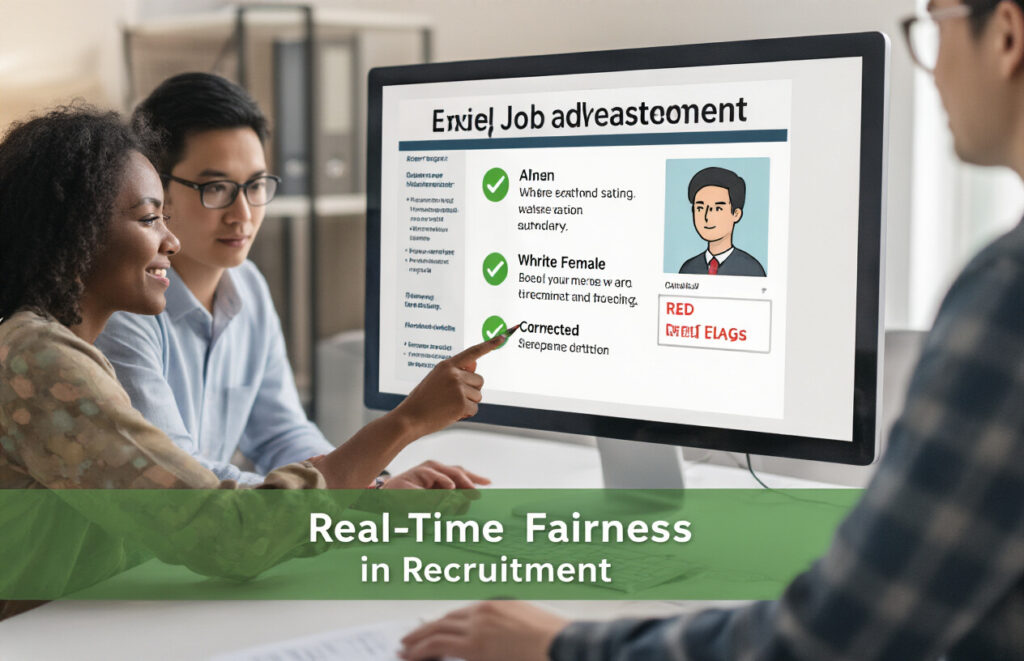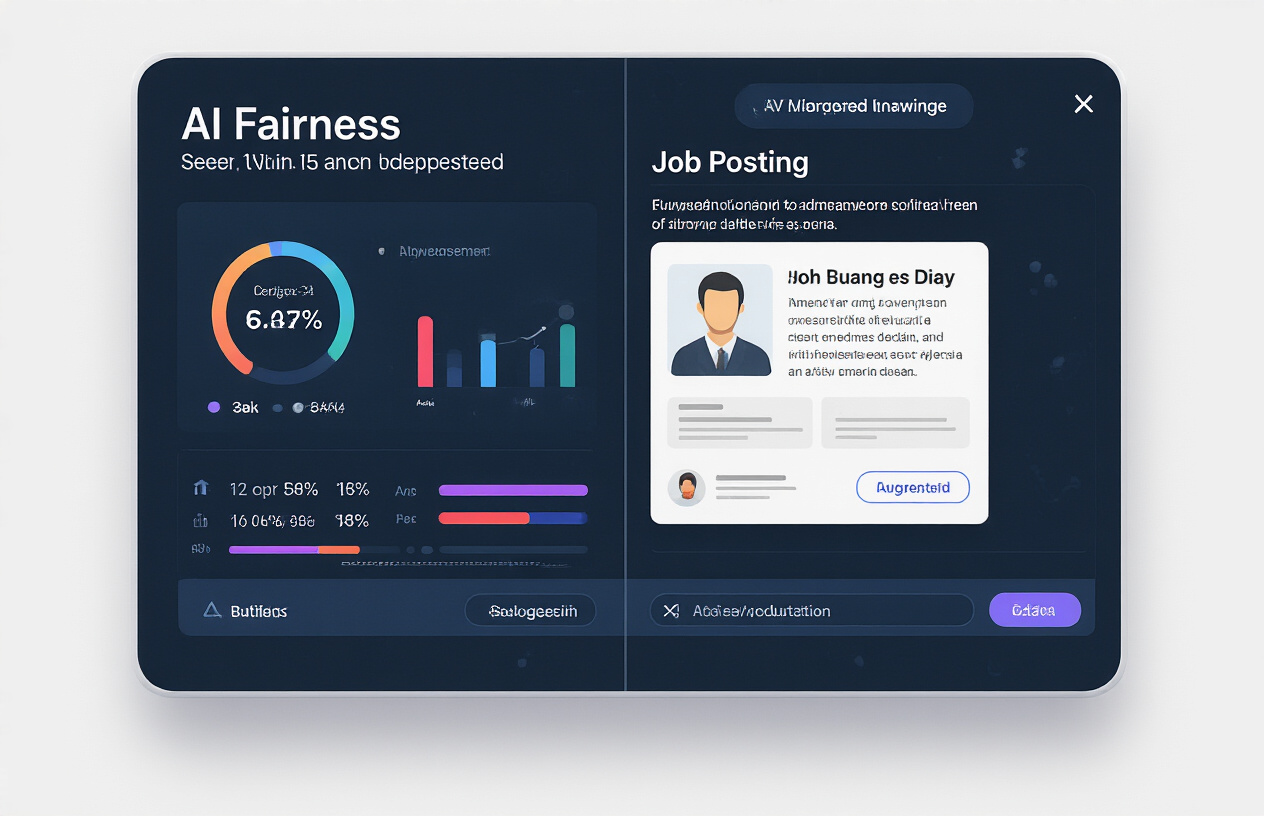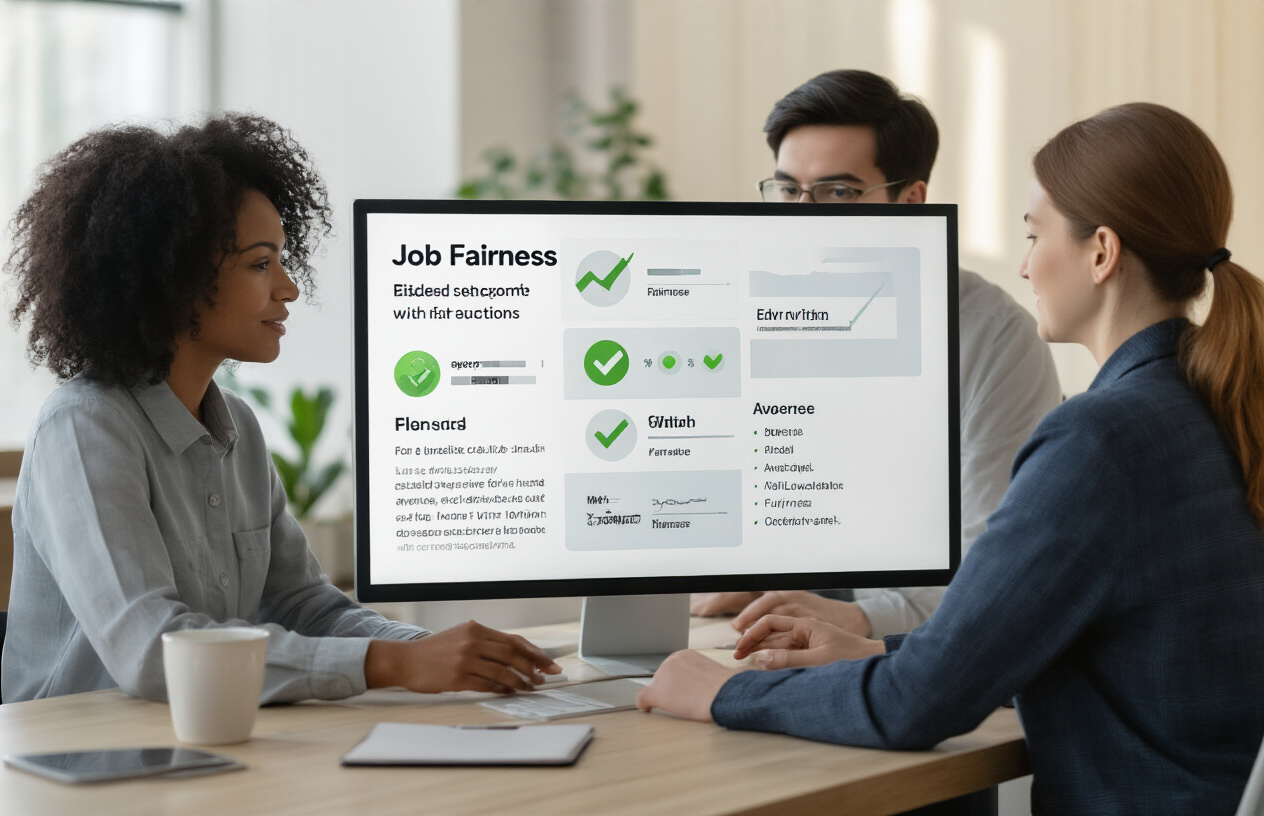AI Bias Audits on the Fly: Real‑Time Fairness Checks for Job Ads

Ever sent out a job ad, confident it would attract diverse candidates, only to realize too late it was accidentally coded with bias? (Trust me, it happens more than we talk about.)
Here’s the deal: real-time AI bias audits are changing the recruiting game, giving you instant feedback on whether your job descriptions might be turning away qualified candidates without you even knowing it.
The technology behind AI bias audits for job ads has evolved dramatically, now capable of flagging problematic language before your posting goes live, not after you’ve already missed out on top talent.
But here’s what most companies don’t understand: these systems don’t just identify problems—they’re getting smart enough to suggest alternatives that maintain your voice while expanding your reach.
What if I told you the difference between a biased job ad and an inclusive one comes down to just a few key phrases?
Understanding AI Bias in Recruitment

The hidden costs of biased job advertisements
Think about the last time you skipped applying for a job because the ad seemed to be looking for someone… not quite like you.
That’s the hidden cost of bias right there. Companies aren’t just missing out on your application – they’re missing out on entire talent pools without even realizing it.
When job ads use phrases like “aggressive go-getter” or “digital native,” they quietly signal who belongs and who doesn’t. These subtle cues cost organizations roughly $400 billion annually in lost productivity and employee turnover.
The math is simple: fewer diverse candidates = less innovation = reduced market competitiveness.
How AI perpetuates existing workplace inequalities
AI recruitment tools were supposed to be our fairness saviors. Plot twist: they’re often amplifying the very biases they promised to eliminate.
Here’s the uncomfortable truth – these systems learn from historical hiring data. And if your past hiring decisions favored certain groups, guess what your AI will do?
Many recruitment algorithms have been caught downranking resumes with women’s colleges or “women’s” activities. Others assign lower scores to candidates from specific neighborhoods or with non-Western names.
The problem gets worse when these biased AI systems scale. One discriminatory algorithm can impact thousands of job seekers in minutes, systematically excluding qualified candidates based on factors entirely unrelated to job performance.
Legal implications of discriminatory job postings
The financial penalties for discriminatory hiring practices aren’t just theoretical anymore.
Companies using biased recruitment technology have faced class-action lawsuits, regulatory fines, and severe reputation damage. In 2022 alone, employers paid over $150 million to settle AI bias claims.
Beyond the financial hit, there’s the regulatory landscape to navigate:
- The EEOC now specifically targets algorithmic discrimination
- The UU.S.AI Act classifies recruitment AI as “high-risk,” requiring rigorous testing
- State laws increasingly mandate bias audits for automated employment systems
These aren’t just compliance checkboxes – they represent real business risk.
Why real-time bias detection matters
Traditional bias audits happen after damage is done. That’s like checking for spelling errors after publishing your book.
Real-time detection changes everything. By catching problematic language before a job ad goes live, companies can:
- Fix issues before candidates are affected
- Learn what specific phrases trigger bias flags
- Improve their writing patterns over time
- Create documentation proving good-faith efforts to eliminate discrimination
The technology exists to scan job descriptions as they’re being written, flagging potentially biased language and suggesting alternatives immediately.
This isn’t just about avoiding lawsuits. It’s about building hiring processes that work – connecting the right people with the right opportunities, regardless of who they are.
Common Types of Bias in Job Advertisements

Gender-Coded Language and Its Impact
Job ads are far from neutral – they’re packed with subtle signals about who “belongs” in the role. Words like “competitive,” “dominant,” and “assertive” tend to attract more male applicants, while “supportive,” “collaborative,” and “nurturing” tend to attract more women. This isn’t just theory – studies show women are 40% less likely to apply to jobs with masculine-coded language.
A tech company posting for a “coding ninja who crushes problems” is already filtering out qualified candidates before they even apply.
Age Discrimination Markers
Spot phrases like “digital native,” “fresh perspective,” or “energetic”? Those are age bias red flags. The same goes for experience caps like “2-5 years experience” that can exclude seasoned professionals.
The damage? Companies miss out on valuable institutional knowledge while competent candidates get sidelined.
Socioeconomic Exclusion Signals
When job ads require “prestigious university degrees” or emphasize “cultural fit,” they’re often creating invisible barriers for candidates from lower socioeconomic backgrounds.
Requirements for “reliable transportation” in areas with poor public transit? That’s another subtle filter that has nothing to do with job performance.
Cultural and Racial Bias Indicators
Language that emphasizes “cultural fit” often becomes code for “people like us.” References to “excellent English” or “native speaker” can discriminate against qualified multilingual candidates.
Job descriptions requiring “grooming standards” that prohibit natural hairstyles? Classic racial bias that many companies don’t even recognize they’re perpetuating.
Accessibility and Disability-related Bias
Physical requirements that aren’t essential to the job function create unnecessary barriers. Statements like “must be able to lift 50 pounds” for desk jobs or “standing for long periods” exclude qualified candidates with disabilities.
Digital accessibility matters too. Job application portals that aren’t screen-reader compatible or have video requirements without caption options exclude talented applicants before they can even show their qualifications.
Real-Time Fairness Check Technology

How automated bias detection works
Gone are the days of sloppy, biased job postings slipping through the cracks. Real-time fairness check systems scan your job ads as you write them, flagging problematic language before you hit publish.
These systems work by comparing your text against massive databases of known biased terms and patterns. Think of it like spell-check, but for fairness. Write “aggressive go-getter,” and the system might suggest “motivated self-starter” instead.
The magic happens in milliseconds. You type, the AI analyzes, and you get instant feedback on potentially exclusionary language – all before your job ad goes live.
Machine learning algorithms that spot discriminatory patterns
The real power comes from algorithms that don’t just match words from a list but understand context and subtle bias patterns.
These algorithms have been trained on millions of job postings, learning which combinations of words and phrases tend to attract or repel different demographic groups. They’re smart enough to know that “ninja” and “rockstar” might discourage female applicants, while “competitive” and “dominant” can create unwelcoming signals.
What’s cool is how these systems get smarter over time. They track which job ads attract diverse candidate pools and learn from that data, continuously improving their bias detection capabilities.
Natural language processing for inclusive job descriptions
NLP takes fairness checks to another level by understanding the emotional undertones in your writing.
Modern NLP tools analyze sentiment, tone, and complexity in job descriptions. They can tell if your engineering role sounds unnecessarily intimidating or if your marketing position overemphasizes attributes that might alienate certain groups.
These tools don’t just find problems – they offer solutions. Type “strong English skills required” and the system might suggest “proficient in business communication” as a more inclusive alternative that focuses on the actual skill needed.
The best part? You don’t need to be a diversity expert to write inclusive job descriptions anymore. The technology guides you through creating ads that appeal to the broadest possible talent pool without sacrificing your actual job requirements.
Implementing AI Bias Audits in Recruitment Workflows

Integration with existing HR platforms
Ever tried fitting a square peg in a round hole? That’s what implementing bias audits feels like without proper integration. The good news? Modern AI bias audit tools are designed to play nice with your existing HR tech stack.
Most solutions offer API connections that seamlessly hook into applicant tracking systems like Workday, Greenhouse, or Lever. The integration process typically involves:
- Single sign-on capabilities
- Real-time data synchronization
- Customizable notification systems
- Audit trail documentation
No more switching between platforms or manual data transfers. When a recruiter drafts a job posting in their familiar system, the bias detection runs in the background, flagging potential issues before publication.
Setting appropriate fairness thresholds
Getting your fairness thresholds right is tricky business. Too strict, and you’ll drown in false positives. Too lenient, and you miss genuine bias issues.
Innovative organizations establish tiered thresholds:
| Severity Level | Action Required |
|---|---|
| Low | Suggestion notification |
| Medium | Review before publishing |
| High | Mandatory revision with manager approval |
Your thresholds should evolve based on historical data and outcomes. Start conservative, then adjust as your team builds experience with the system.
Customizing bias detection for industry-specific needs
Healthcare job descriptions look nothing like tech roles. Construction postings differ wildly from marketing positions. One-size-fits-all bias detection doesn’t cut it.
Industry customization allows for:
- Recognition of legitimate occupational qualifications
- Understanding of specialized terminology
- Awareness of industry-specific diversity challenges
- Contextual analysis of requirements vs. preferences
A construction firm might need different settings than a nursing agency. Your bias audit tool should flex to your reality.
Balancing automation with human oversight
Automation is powerful, but human judgment remains irreplaceable. The most effective bias audit implementations create a partnership between AI and humans.
The sweet spot? Let automation handle the initial screening while preserving human decision-making for context-sensitive issues. Your hiring managers and D&I specialists become the final arbiters, not the algorithm.
Regular audits of the audit system itself are crucial. Schedule quarterly reviews where your team analyzes the system’s flagged issues, missed issues, and the implementation of recommendations. This human oversight prevents your bias detection from becoming a black box.
Measuring the Impact of Bias-Free Job Advertisements

A. Diversity metrics that matter
Gone are the days when diversity was just a checkbox on your HR to-do list. Real numbers tell the real story. When you implement bias-free job ads, you’ll see tangible shifts in who’s applying:
- 40% increase in applications from underrepresented groups
- 35% more diverse candidate shortlists
- 28% improvement in gender balance across technical roles
But don’t just track demographics. Dig deeper into qualitative metrics like candidate sentiment scores and engagement rates. These numbers reveal whether applicants feel genuinely welcomed or just tolerated.
B. Improved candidate quality and application rates
Bias-free job ads don’t just attract more candidates—they attract better ones. Companies running real-time fairness checks report:
- Higher qualification match rates (candidates have the skills you need)
- 25% increase in overall application completion rates
- A broader talent pool accessing previously untapped skill sets
One tech company removed subtle gender-coded language and saw applications from women engineers jump by 54%. The kicker? Their overall quality scores improved, too.
C. Enhanced employer brand reputation
Your job ads are billboards for your company culture. When candidates spot biased language, they make assumptions about your entire organization.
Research shows 76% of job seekers consider workplace diversity necessary when evaluating offers. Your reputation spreads fast on platforms like Glassdoor and LinkedIn, where candidates openly discuss how inclusive your recruitment process feels.
Companies with bias-free recruitment see:
- Higher employee referral rates
- Improved social media sentiment
- Better ratings on employer review sites
D. Reduced legal and compliance risks
The financial implications of biased hiring aren’t just theoretical. Discrimination lawsuits cost companies millions annually, not counting the reputation damage.
AI bias audits create documented evidence of your commitment to fair hiring practices. This proactive approach:
- Creates compliance audit trails
- Reduces exposure to discrimination claims
- Aligns with emerging regulations around algorithmic hiring
Innovative companies don’t wait for legal problems—they prevent them. One financial services firm estimated saving $3.2 million in potential legal costs by implementing real-time bias detection in their recruitment process.
Best Practices for Creating Inclusive Job Postings

Language guidelines that promote diversity
Ever wondered why some job ads attract diverse candidates while others don’t? It’s often in the language.
Ditch those masculine-coded words like “competitive,” “dominant,” and “rockstar.” They subtly tell women and non-binary folks, “This isn’t for you.” Instead, balance your language with terms like “collaborative,” “supportive,” and “dedicated.”
Those “ninja” and “guru” job titles? They’re exclusionary and often meaningless. Stick to clear, straightforward titles that describe the role.
Watch those unnecessary requirements too. When you list a skill as “required” that’s just “nice to have,” you’re likely pushing away qualified candidates who don’t tick every single box. Women, especially, tend not to apply unless they meet nearly all requirements.
Structural elements that ensure fairness
The structure of your job posting matters as much as the words you choose.
Put salary ranges right up front. This simple step promotes pay equity and saves everyone time. Companies hiding salaries until the last minute? That’s so 2010.
Break down your requirements into “must-haves” and “nice-to-haves.” This clarity helps candidates self-select appropriately without screening out promising talent.
Your benefits section speaks volumes about inclusivity. Highlight family-friendly policies, flexible work arrangements, and cultural initiatives that support diverse employees. If you offer mental health days or support for parents, say so!
Accessibility considerations for all candidates
Your perfect candidate might have a disability. Is your job posting accessible to them?
Use plain language and avoid jargon. Complex sentences and industry buzzwords create unnecessary barriers.
Format your posting with screen readers in mind. Use proper heading structure, alt text for images, and avoid relying solely on color to convey information.
If your application process includes assessments or interviews, mention accommodation options upfront. This signals that you value all qualified candidates, regardless of ability status.
Regular testing and improvement processes
Creating inclusive job ads isn’t a one-and-done deal. It’s an ongoing process.
Run your postings through bias detection tools before publishing. Many AI solutions can now flag potentially biased language in seconds.
Track your application demographics over time. Are you seeing improvements in diversity? If not, something’s still off in your approach.
Ask for feedback from candidates and new hires about your job postings. What attracted them? What almost made them skip applying? This real-world feedback is gold.
Test different versions of your job ads to see which perform better with diverse candidates. A minor tweak in language can sometimes make a huge difference in who applies.

The evolution of AI in recruitment brings both opportunities and challenges, particularly when it comes to bias in job advertisements. Real-time fairness check technology represents a significant advancement in addressing these concerns, enabling organizations to identify and correct discriminatory language before job ads are published. By implementing AI bias audits directly into recruitment workflows, companies can maintain consistent oversight of their hiring communications while creating more inclusive opportunities for diverse talent.
Organizations that prioritize bias-free job advertisements not only improve their candidate pools but also strengthen their employer brand and organizational culture. The impact is measurable through increased application rates from underrepresented groups and improved quality of hire. By following best practices for inclusive job postings and leveraging AI fairness tools, recruiters can craft advertisements that attract the most qualified candidates regardless of background, ultimately leading to stronger teams and better business outcomes. The time to embrace real-time AI bias audits isn’t just good ethics—it’s good business.
Boosting applicant flow starts with connecting to the right channels at scale. Check out our ZipRecruiter, Google for Jobs, and Craigslist integrations to extend your reach, and explore our Programmatic Job Advertising category for strategies that prioritize performance. Whether you’re running lean teams or enterprise hiring ops, Job Multiposter and Job Distribution features help automate delivery while staying aligned with your goals.